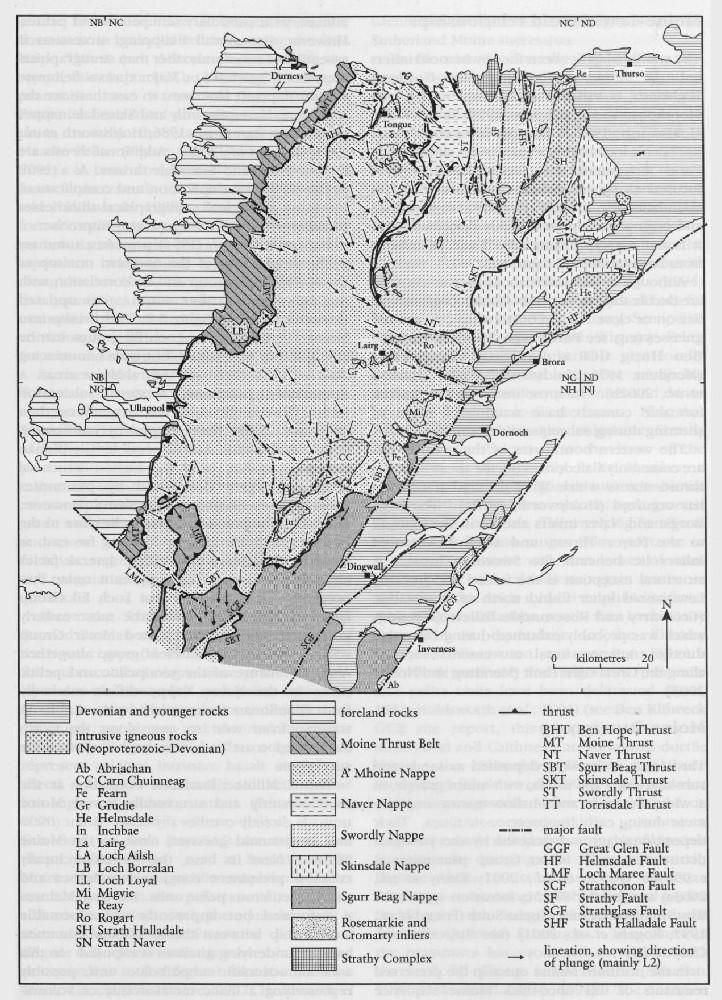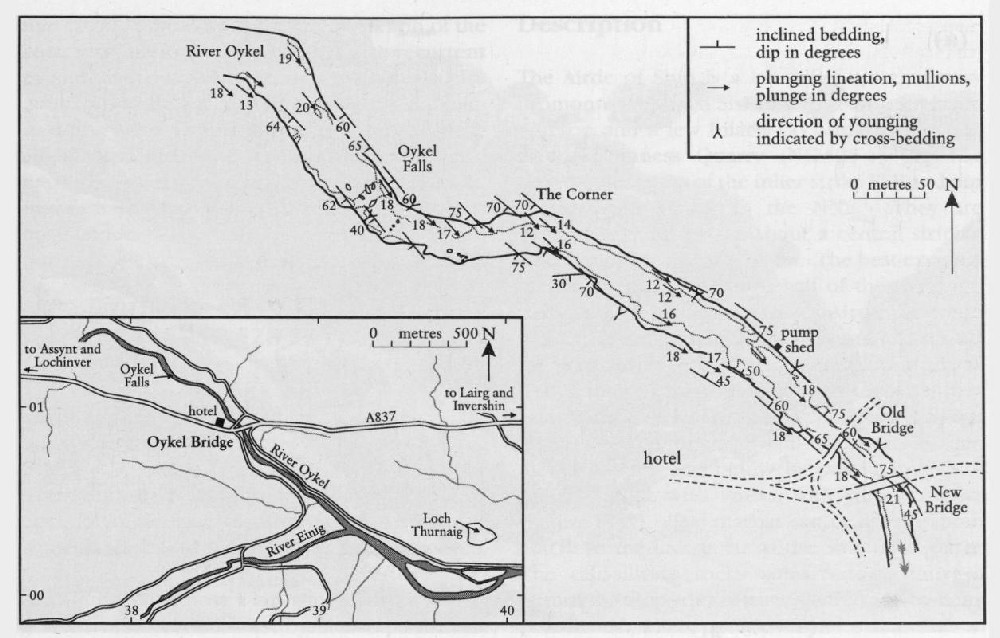Oykel Bridge
N.J. Soper
Introduction
The Oykel Bridge section exposes some of the finest examples of mullion structures to be seen in Britain. Wilson (1953) described mullions as 'clustered columns made of the local country rock', which here are Moine psammites belonging to the
In structural terms, mullions are a type of linear structure, commonly associated with, and parallel to, fold axes and mineral alignments. The terms 'mullion' and 'rodding structure' were initially used indiscriminately, but Wilson used examples from Oykel Bridge and Ben Hutig (see Ben Hutig GCR site report, this chapter) to distinguish mullions, columnar structures composed of the country rock, from rods, found in deformed quartz veins and pebbles enclosed within the rock. Wilson differentiated 'fold', 'cleavage' and 'irregular' mullions, as described below. It was recognized from the days of the primary survey that the Moine rocks of Sutherland are characterized by a SE-plunging mineral lineation, roughly normal to the Moine Thrust Belt, and referred to on the geological maps as a 'direction of stretching in schistose rocks'. The mullions, rods and early 'D2' fold axes lie parallel to this regional lineation
British structural geologists were at this time much influenced by the German 'sytnmetrologicar school of Sander and others (e.g. Sander, 1930, 1934), which sought to deduce the kinematic (movement) pattern from the geometry and orientations of rock structures and microfabrics. Tectonic axes were defined in terms of a co-ordinate system related to the symmetry of a structure. For example in a fold pair with monoclinic symmetry, 'b' would be the principal fabric axis (the fold axis or hinge line), 'ab' the axial surface, and 'ac' the plane of symmetry (or profile plane) normal to 'b' (e.g. Wilson, 1961). It was assumed that folds form by displacement parallel to the axial surface and at a right angle to the fold axis, so 'a' defined the movement direction and 'b' an axis of rotation. With hindsight this is only one end member of a whole range of geometrical relationships between folding and displacement. It is now known that fold axes form in directions determined by the orientation of bedding in relation to incremental strain at the time of their initiation. Once formed the fold axes can rotate towards the principal extension direction, so there is no simple relationship between fold symmetry and finite strain, or to 'movement'.
Wilson (1953) in his classic description of the Oykel Bridge mullions interpreted them as the products of 'rolling or shearing movements acting at right angles to their lengths', as had Phillips (1937) in his regional microfabric study of quartz c-axis orientations in Moine psammites: they were 'b'-lineations. Wilson did not accept that the mullions had formed by stretching parallel to their length. Phillips on the other hand appears to have accepted the view of Clough (in Peach et al., 1912) that rodding and similar structures had been subjected to 'pressures from four sides in opposite pairs, leaving constituents to squeeze out...'. Expressed in modern terms of strain, Clough was describing a constriction–extension or cigar-shaped prolate strain ellipsoid, whose principal extension direction was marked by the regional SE-plunging lineation. Both Wilson and Phillips denied that the SE-plunging structures had any relationship to movements on the Moine Thrust, regarding the main tectonic and metamorphic evolution of the Moines (that produced the mullions) as earlier than the Caledonian thrusting, and thus of Proterozoic age.
In contrast, workers in the Moine Thrust Belt such as Read (1931) and Bailey (1935) regarded the SE-plunging linear fabric in the mylonites as marking a north-westerly direction of thrusting, normal to the thrust front: they were 'a'-lineations. The 'a'- vs 'b'-lineation argument reached its ultimate absurdity when Christie (1963) used symmetry alone to infer, quite counter-intuitively, that displacement on the Moine Thrust had been to the south-west, parallel to the thrust front and at right angles to the dominant fold axes and linear structures (including the mullions).
Description
The mullions are displayed in the gorge of the River Oykel between the new road bridge
ENE-striking joints provide cross-sections of the mullions. The best developed are 'fold mullions' as defined by Wilson (1953) and are commonly concavo-convex in section
There is a well-developed mineral elongation alignment parallel to the axes of the mullions; this is the regional lineation, designated L2 (e.g. Strachan and Holdsworth, 1988). Where a micaceous sheath is developed, commonly it also carries a weak crenulation fabric, oblique to the mullion axis.
Interpretation
It is now apparent that the early surveyors such as Clough (in Peach et al., 1912) were correct to interpret the regional SE-plunging mineral lineation as marking the principal extension direction of the main deformation to which the Moine rocks had been subjected. The lineation does indeed also correspond with the direction of displacement in the Moine Thrust Belt, with kinematic indicators indicating top-to-the-NW (Holdsworth and Grant, 1990). The regional F2 folds, and the locally developed mullions, were formed within this regional D2 strain/ displacement field. Statistical parallelism of the fold axes and the lineation is thought to be due to passive rotation of the axes towards the extension direction, locally giving a sheath-like fold geometry. Rodded pebbles in the A'. Mhoine Psammite Formation at Ben Hutig were the subject of a strain study by Wood (1973), who interpreted them as having extremely prolate shapes (but see Ben Hutig GCR site report, this chapter).
While this would account for the coincidence of fold-mullion axes with the lineation, and their near-perfect columnar form, the mechanism by which they developed into discrete but interlocking bodies has not been established. It is here suggested that inner-arc space problems associated with the antiformal 'Einig Syncline' at Oykel Bridge, combined with flexural slip on non-parallel surfaces (bedding and cross-bedding) that were deforming within a constrictional strain field, led to the initiation of many small roughly coaxial folds. These folds developed with variably oriented axial surfaces, and eventually 'detached' to form the nested columns. Note that mullions also occur in the Coldbackie Bay GCR site where they are attributed to coaxial F2 and F3 folding. However, in both sites the psammites occur in a similar structural situation in areas of high prolate strain close to D2 fold hinges. At Oykel Bridge the constrictional strain also appears to result from superimposed deformations that relate regionally to stacking of thrust sheets in the Moine sequence and to the mylonites of the Moine Thrust Belt.
Conclusions
The spectacular mullions in Moine psammites displayed at Oykel Bridge are columnar structures whose long axes plunge 10°–20° to the ESE, parallel to a regional elongation lineation and to the axes of the dominant set of folds (F2) that affect the Moine rocks. Their origin and significance has long been the subject of debate. Were they produced by compression normal to their length, or extension parallel to it? Were they associated with major Precambrian orogenic movements at right angles to their length, or with Caledonian transport to the north-west on the Moine Thrust, parallel to it? The current view is that mullions developed parallel to the principal stretching direction during the main, Caledonian deformation of the Moine rocks, probably associated with recurrent movements along the Moine Thrust Belt. The deformation was of constriction-extension type, resulting in a prolate (flattened cigar-shaped) strain ellipsoid. The Oykel Bridge section exposes some of the finest examples of mullions in Britain and the site is of national importance.



